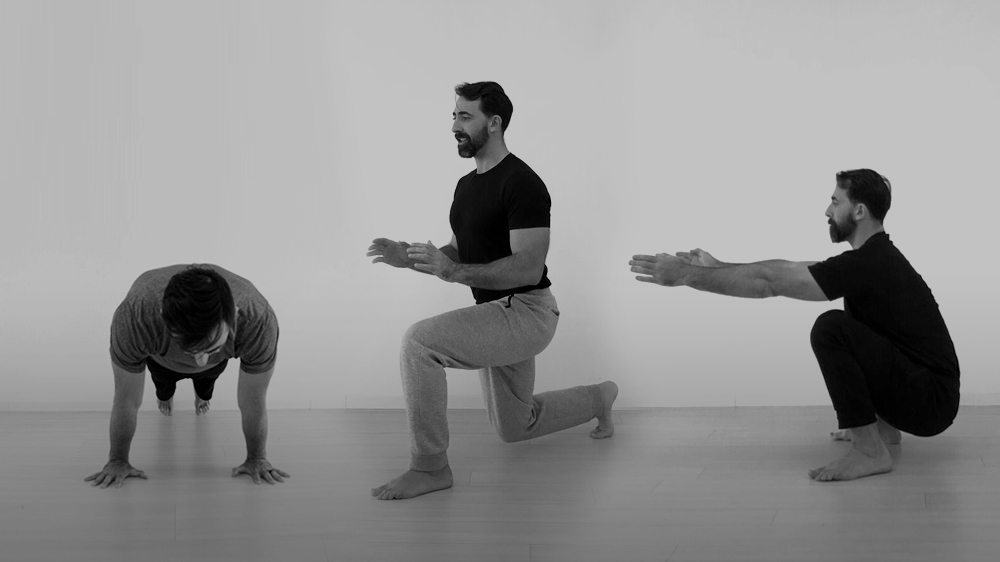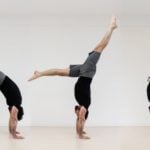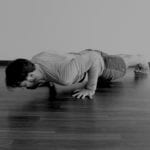So you’ve been thinking about getting started with bodyweight training, but you don’t know where to begin.
And that makes a lot of sense, because a quick Google search will pull up approximately 7 bajillion websites, each telling you to focus on different things.
- “193 Bodyweight Exercises You Can Do Anywhere!”
- “37 Exercises You Must Do Right Now, Or You’ll Die!”
- “The 86 Absolute Best Bodyweight Exercises That Will Lead to Immortality, Spiritual Enlightenment, and the Biceps You’ve Always Wanted”
You get the idea.
But if you look a little more closely at most of those lists, they’re just a bunch of variations of the same few exercises.

So, in this article, I want to talk about the core 5 exercises most beginners want to get when they start bodyweight training, and what’s likely going to get in your way of achieving those skills. Then, I’ll share my favorite exercises to help you overcome those hurdles and get to your goals.
5 Basic Bodyweight Exercises Everyone Wants to Learn (and what might get in your way)
I’ve said it before, and I’ll say it again: There’s no such thing as a “new” exercise.
Humans have been moving their bodies for as long as there have been humans, so every pattern of movement has been practiced before.
But what’s cool about that is that all those fancy exercises you see out there stem from the same few movements. Which means, if you get good at those movements, the world is your oyster.
If you’ve done a bit of poking around on ye olde interwebz, everyone tells you that you should be working on the same 5 skills, with countless variations. In this video, I’m going to run through those 5 exercises and show you what issues you might run into if you’re just starting out.
As you can see from the video, while these exercises may be the origins for a lot of other skills, if you’re just starting out, you may have a lot of barriers standing in your way. Let’s go through each exercise and identify what it entails.
🆓 Get our free bodyweight routine and we’ll walk through how to master all 5 exercises. Click here to download the video. Yours free. 🙂
1. Squat
 It doesn’t get more basic than the squat. And when starting out with bodyweight training, many people go after the king of all bodyweight squats: The Ass-to-Grass Squat.
It doesn’t get more basic than the squat. And when starting out with bodyweight training, many people go after the king of all bodyweight squats: The Ass-to-Grass Squat.
That’s where you can squat deeply enough that, well, your ass is touching the grass.
Being able to squat that deeply with good form means having access to a wide range of movements and skills that might not be possible otherwise.
You don’t necessarily need to get your ass to the grass (despite what some might say), but if your range of motion in the squat is limited, you’ll have trouble with, not just other exercise goals, but also many daily activities.
As a beginner to bodyweight training, here’s what might get in your way with getting a deep squat:
If any of that sounds familiar, you likely struggle with more than just the squat.
2. Push-Up
 The push-up is a classic bodyweight exercise we’ve all done (or attempted) at some point or another. And it’s one of my favorite exercises.
The push-up is a classic bodyweight exercise we’ve all done (or attempted) at some point or another. And it’s one of my favorite exercises.
Done with proper technique, the push-up strengthens the shoulders, chest, elbows, and even the legs and glutes. It’s truly a full-body exercise that encourages mindful awareness of the entire body to maintain a solid structure.
But if you’re just getting started with bodyweight training, there’s a good chance you can’t do a single push-up, or you can only do them with unsafe technique.
Here are some possible reasons you’re having trouble:
- Weak shoulder girdle
- Poor mobility in the shoulders
- Limited strength and motor control in the core
- Weak legs
Practicing push-ups if you’re not ready for them yet can result in doing them with form that is unsafe for the joints in the long run. That’s why a lot of people will say that their shoulders or elbows or lower back hurt when doing push-ups–it’s no fault of the exercise itself, but of the form they’re using.
3. Pull-Up
 It may seem simple to hang from a bar and pull your body up, but for someone just starting their journey with bodyweight training–and even for many people who’ve been training for a while–the pull-up can feel impossible and out of reach.
It may seem simple to hang from a bar and pull your body up, but for someone just starting their journey with bodyweight training–and even for many people who’ve been training for a while–the pull-up can feel impossible and out of reach.
So many bodyweight “gurus” will say that pull-ups are an essential exercise, and promote incorporating passive hangs into your daily routine.
But for a lot of people, even hanging on a bar is beyond their current capabilities–and that’s totally okay. I’m a big fan of pull-ups, but while I agree that pulling strength is an essential component of a well-rounded physical skillset, I don’t think you can skip over the basics without running into trouble.
With that said, here are some of the things that might be getting in your way with pull-ups:
- Weak shoulder girdle
- Poor grip strength
- Limited shoulder mobility
- Instability in the core
If you have any of these things going on and you attempt to do pull-ups, you’ll likely compensate in ways that are not only unsafe, but also prevent you from getting all the benefits you can from proper pull-ups.
4. Lunge
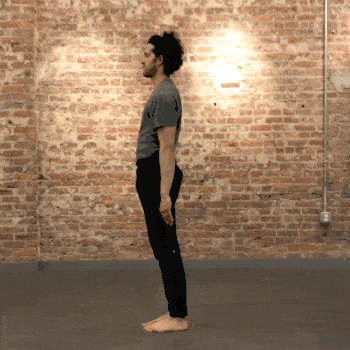 There are many different types of lunges, but the one I usually have people start with is the reverse lunge, as I show in the video.
There are many different types of lunges, but the one I usually have people start with is the reverse lunge, as I show in the video.
Lunges are a great way to strengthen the legs, both anteriorly and posteriorly, while coordinating movements and muscular contractions in the front leg and the back leg. There aren’t too many exercises that can do all of that at once.
The problem? If you’re lacking sufficient strength and body awareness, you risk doing lunges in a way that can tweak your knees or your back, and we don’t want that.
Here are some of the things that could make it difficult to do lunges with proper form:
- Tight hip flexors
- Weak glutes, hamstrings, and/or quads
- Limited spinal mobility
- Poor body awareness
- Insufficient coordination
Many people try to jump right into all different kinds of lunges, only to discover that lunges “hurt their knees.” Well, much like the push-up, it’s not a problem with the lunge itself, but with the person’s form.
5. Dip
 Last, but not least, the dip. This is a deceptively difficult exercise, especially if you haven’t spent much time maneuvering your bodyweight through different positions.
Last, but not least, the dip. This is a deceptively difficult exercise, especially if you haven’t spent much time maneuvering your bodyweight through different positions.
Dips can be done on the rings, like I show in the video, or on parallel bars, and you’ll get many of the same benefits. This exercise helps to not only build powerful pushing strength, but it also stretches the pecs, which have a tendency to get quite tight on people.
But if you’ve never done them before, you’ll have to be careful. A lot of people think dips are easy peasy, only to discover that they’re quite challenging.
Jumping in without proper preparation can result in injury to various parts of the shoulder girdle.
Here’s what might get in your way with dips:
- Poor shoulder mobility
- Grip weakness
- Weak triceps and forearms
- Lack of control in the shoulder girdle
Any of these issues can make it very difficult, if not impossible, to do dips with safe and effective form.
Let’s get into the exercises that will help you shore up your weaknesses for dips and the rest of the exercises listed above.
Two Fundamental Bodyweight Exercises to Help You Master These Skills
Those 5 basic bodyweight exercises are great, and they all have tremendous benefits. But they’re built around a sort of simplistic idea of what fitness is–you need pushing strength, pulling strength, leg strength, etc.
At any stage of fitness, though, and especially if you’re just starting out, what you really want is for your body to work well in all sorts of situations–not just while doing bodyweight workouts.

By working on just two skills–the squat and the bear–you’ll be training your body to work together as a coordinated whole, while also building strength and mobility in all the places you need it to feel more capable in any situation.
Of course, to actually get a pull-up or push-up, or any of the other skills mentioned, you’ll eventually have to practice those skills directly. But by practicing these two exercises, you’ll be giving yourself a strong foundation in the attributes needed to build those skills. Here’s how that works:
Squat: Lower Body Strength and Mobility
So you want to get a deep, ass-to-grass squat, and a solid lunge. We identified some things above that might be getting in your way, including tight hips and spine, weak glutes and hamstrings, poor body awareness, among other things.
To improve these attributes, we work on the squat from the ground up.
We talk about this in more detail in our Squat tutorial, but working on your squat incrementally and progressively will help you improve your:
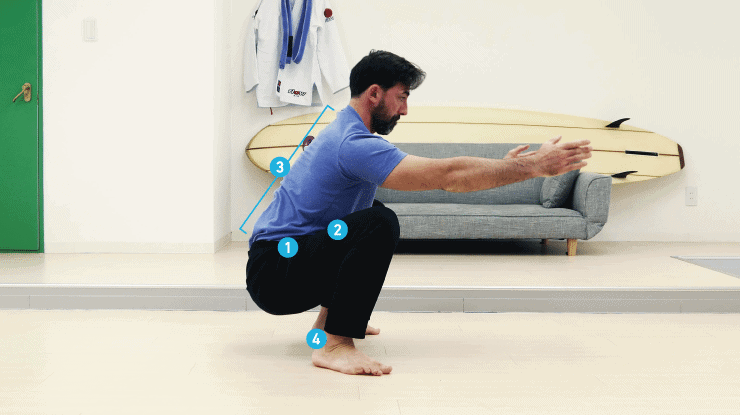
- hip mobility and strength
- quad strength
- trunk stability
- ankle mobility
Pretty much, all the things that will likely hold you back from achieving some of the skills you’ll want to get as you continue your bodyweight exercise journey.
Bear: Shoulder Function and Overall Coordination
All three of the other skills listed above–push-ups, pull-ups, and dips–have a lot of shoulder involvement, as well as coordination throughout the body.
Some of the common issues that could hold you back with those skills are: weakness and immobility in the shoulder girdle, instability in the core, poor grip strength, and lack of coordination and motor control.
The Bear, and its many variations, help address all of these problem areas. It will help you improve:

- hip strength
- hamstring flexibility
- grip strength (as you grip the floor)
- shoulder strength and mobility
- spinal extension
- cross body coordination
- pressing strength going backward
- pulling strength going forward
It may seem counterintuitive to work on the bear when you’re trying to improve your push-ups, pull-ups, and dips, but it’s a movement that will help you build the attributes you need to get those skills more easily (and safely).
Build Your Foundation for Bodyweight Training
No matter what your goals are, you need a strong foundation in the basics to be able to reach your goals faster and more easily, and to set yourself up for success.
The bear and the squat will take you a long way toward that foundation, and they feature prominently in our Elements course. Elements will help you build all the attributes you need to make progress toward your goals, and it’s the best place to start with bodyweight training.
Get the Attributes You Need for the Skills You Want
Elements will help you build the fundamental attributes needed to work toward the bodyweight skills you want.
